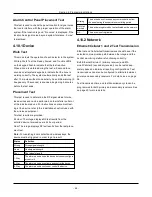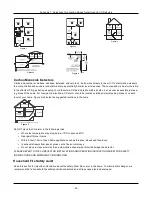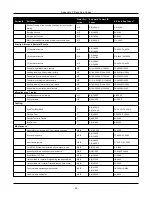
Section 4: Programming Options
4.8 Available Zone Attributes
The following table defines each available zone attribute.
Alarm Report
When this attribute is enabled, zone alarm and restore
events are transmitted. When disabled, zone alarm
events are not transmitted but are logged to the event
buffer.
Chime
When this attribute is enabled, the keypad chimes
when the zone is opened or closed.
Burglary Veri-
fied
When this attribute is enabled, zone alarms are not
communicated until a burglary verified event occurs.
Transmission
Delay
When this attribute is enabled, reporting of zone
alarms is delayed for the programmed time. If a valid
access code is entered within this time, no alarm signal
is communicated. When disabled, reporting codes are
transmitted immediately.
Bell Audible
When this attribute is enabled, an alarm activates the
siren. When disabled, alarms are silent.
Bell Steady
When this attribute is enabled, siren output is steady
when in alarm. When disabled, siren output pulses dur-
ing an alarm.
Bypass
Enable
When this attribute is enabled, the zone can be manu-
ally bypassed. When disabled, the zone cannot be
bypassed.
Force Arm
When this attribute is enabled, the system can be
armed with the zone open. The zone is temporarily
bypassed and, when secured, is monitored by the sys-
tem. When disabled, the system cannot be armed with
an open zone.
Swinger Shut-
down
When enabled, a zone that goes into alarm for the num-
ber of times programmed in the Swinger Shutdown
Counter shuts down with no further transmissions sent
to the monitoring station. The siren follows swinger
shutdown if programmed. When disabled, all alarms
are transmitted.
Two Way
Audio
When this attribute is enabled, the panel is able to ini-
tiate a 2-way audio session. When not enabled, only
the panel microphone turns on, initiating a listen-in only
session. The speaker remains off.
Talk Listen
4.9 Diagnostics - Read Only
Radio Version#
This section displays the software version of the cellular
radio.
Primary Telephone Number
This section displays the cellular telephone number of the
SIM.
IMEI number
This section displays the unique 15-digit International
Mobile Equipment Identity (IMEI) of the radio. The format of
the IMEI is: Reporting Body Identifier (2 digits), Allocation
Number (4 digits); Final Assembly Code (2 digits); Serial
Number (6 digits); and a check digit.
SIM Number
This section displays the Subscriber Identity Module (SIM)
number of the SIM card installed in the communicator. The
format of the SIM number is: Major Industry Identifier (2
digits); Mobile Country Code (2 or 3 digits); Mobile Network
Code (2 - 3 digits); Unique Number (10 -12 digits); and
Checksum (1 digit). Valid SIM numbers range is: 18 - 21
numbers. This number is printed on the SIM and the outside
of the communicator carton.
Note:
The checksum digit is omitted on 19-digit SIM card
numbers.
SIM Activated
Cellular Device Type
This section displays the type of cellular module used by the
system. E.g., UE910-N3G, LE910-SVG
Cellular Signal Strength
This section displays the strength of the cellular signal:
Strong, Weak, None.
Radio Network Technology
This section displays the mobile wireless tele-
communications technology used by the cellular radio.
Provider ID#
This section identifies number of the telecommunications ser-
vice provider.
4.10 System Control
Use this section to perform the following diagnostic tests.
System Test
This test is used to check that the iotega‘s siren and LEDs
are operating correctly. This is a hardware test only. No sig-
nals are transmitted to the monitoring station. During the
test, the LEDs flash.
- 43 -
















































